Photographs by Aviva Rowley
“We are interested in facilitating that online and offline relationship, making technology a social activity,” says Chloe Varelidi, the co-creator of Minicade, a community-building game and website and one of the featured works at Eyebeam's 2015 Annual Showcase. The non-profit art and technology center's yearly fair, which opened January 29th in DUMBO, Brooklyn, gives an intimate and eclectic look into the work of Eyebeam's 2014 residents.Some of the most interesting works at this year's fair focused on the social aspect of art and technology. From games that teach coding, to a device that kills cell phone frequencies in order to promote intimacy, to an interactive architectural dance project, these are projects that use tech-based art to encourage public participation, create better communities, and expand the ways in which we think about social interaction.Below, take a look at some of the projects currently on display at Eyebeam's 2015 Annual Showcase: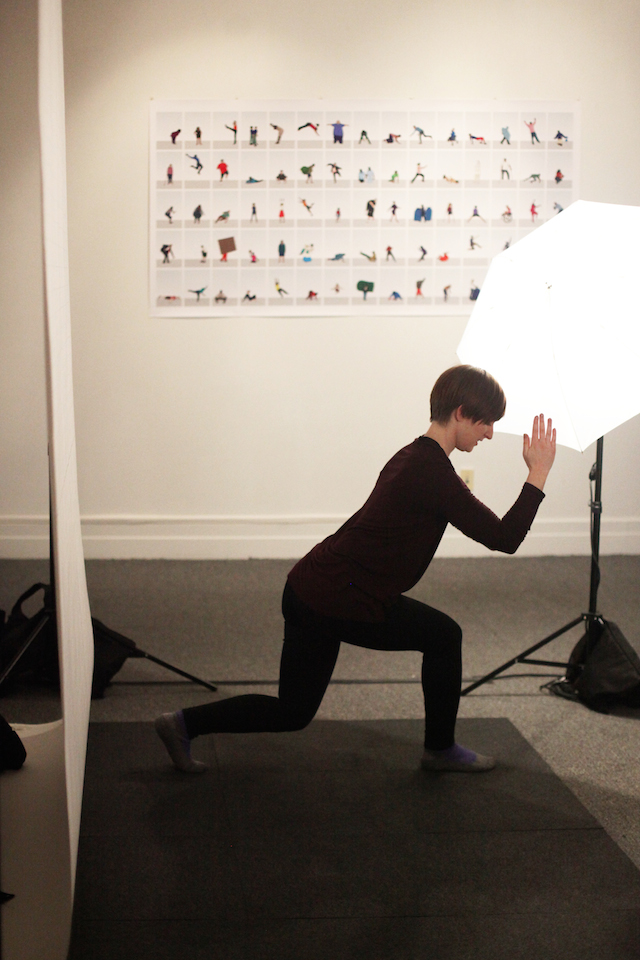 Next to a poster of colorfully illustrated people in a variety of odd positions, a woman moves sporadically while the crowd watches on and Nancy Nowacek, a performance artist who explores the relationships between bodies and spaces, directs. The dancer acts out prompts written on large index cards in front of her, taking Nowacek's suggestions. One reads: You are an older man in coveralls turning a slow somersault backwards down a flight of stairs. You are not falling. The movements looks similar to the pictures on the poster.
Next to a poster of colorfully illustrated people in a variety of odd positions, a woman moves sporadically while the crowd watches on and Nancy Nowacek, a performance artist who explores the relationships between bodies and spaces, directs. The dancer acts out prompts written on large index cards in front of her, taking Nowacek's suggestions. One reads: You are an older man in coveralls turning a slow somersault backwards down a flight of stairs. You are not falling. The movements looks similar to the pictures on the poster.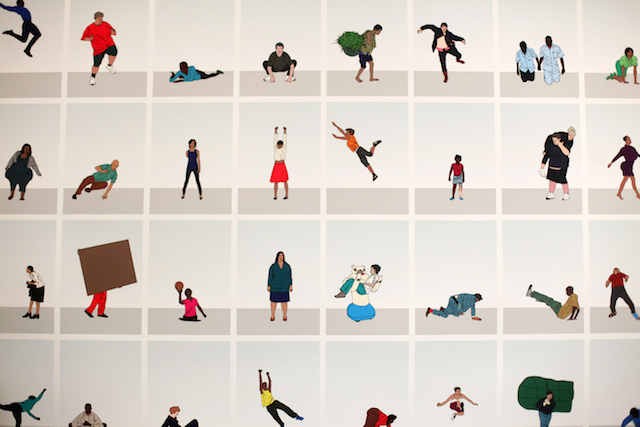 Using the public to reenact human movements and creating an open-sourced library of human figures with Google's SketchUp Warehouse, Nowacek's latest project aims to integrate images of “real people” into the technologized design process. “The body has become an almost useless part of technology,” she explains. The work reads as something like an architectural sketch, where the people pictured tend to look more like confused Sims characters than those who might actually use the space. By documenting the movements of real people (i.e an older man in coveralls) doing real things (somersaulting down stairs, not falling, etc.) Nowacek hopes to pose the question “What if architecture could start from the person rather than the structure?”
Using the public to reenact human movements and creating an open-sourced library of human figures with Google's SketchUp Warehouse, Nowacek's latest project aims to integrate images of “real people” into the technologized design process. “The body has become an almost useless part of technology,” she explains. The work reads as something like an architectural sketch, where the people pictured tend to look more like confused Sims characters than those who might actually use the space. By documenting the movements of real people (i.e an older man in coveralls) doing real things (somersaulting down stairs, not falling, etc.) Nowacek hopes to pose the question “What if architecture could start from the person rather than the structure?”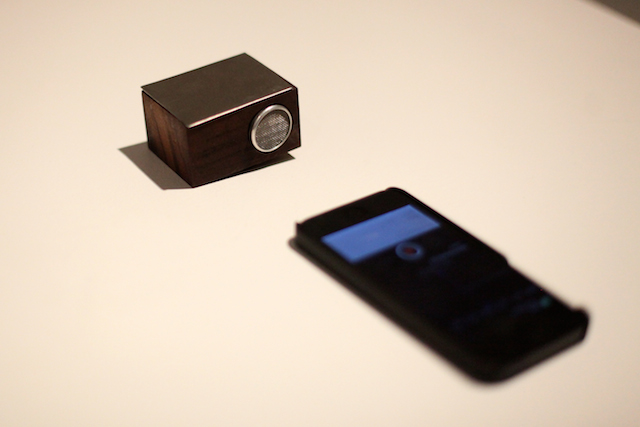 “I look at privacy issues as the gentrification of our souls,” says artist and coder Allison Burtch, whose small but powerful Eyebeam project is both a political statement and a way to regain intimacy in a world saturated with technology. “Every part of us is now data, and it's being extracted for profit,” she says, showing a tiny box that cuts out cellphone frequencies when any iPhone is placed in its path. Voice memo recordings immediately go silent.Like Burtch's recent Log Jammer piece—a cell phone jammmer disguised as a log to hide in wifi-ready parks—this frequency jammer gives privacy and anonymity to conversations that might accidentally become recorded or overheard. Even further, the ability to temporarily manage our technology's connectedness gives a welcomed and rare sense of control, providing a option for silence and the necessary chance to unplug.
“I look at privacy issues as the gentrification of our souls,” says artist and coder Allison Burtch, whose small but powerful Eyebeam project is both a political statement and a way to regain intimacy in a world saturated with technology. “Every part of us is now data, and it's being extracted for profit,” she says, showing a tiny box that cuts out cellphone frequencies when any iPhone is placed in its path. Voice memo recordings immediately go silent.Like Burtch's recent Log Jammer piece—a cell phone jammmer disguised as a log to hide in wifi-ready parks—this frequency jammer gives privacy and anonymity to conversations that might accidentally become recorded or overheard. Even further, the ability to temporarily manage our technology's connectedness gives a welcomed and rare sense of control, providing a option for silence and the necessary chance to unplug.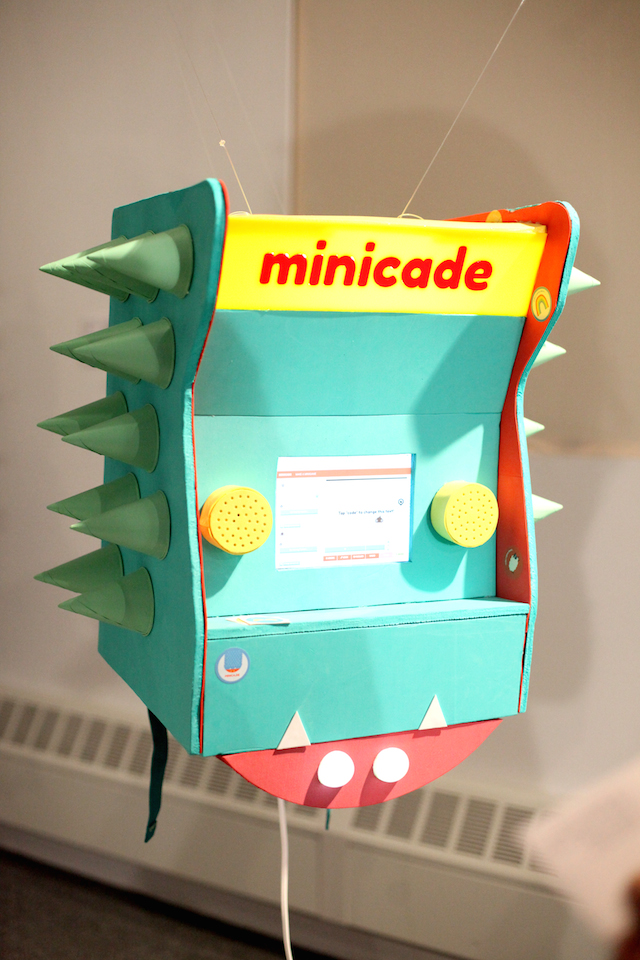 Kill the yellow monster, eat the marshmallow, don't step on a cartoon poo: it's all pretty simple with Varelidi and Varma's Minicade, a website and app where you can collaboratively build mini arcade games with multiple users. However, it's this simplicity that makes the project exceptional. Users can either play one of the games provided or remix the mini-game with a set of tools, accessible either visually or through an incredibly easy-to-read drag and drop HTML code menu that mimics a puzzle. Change the color of a monster or add in your own unique or swear word when you step on a poo, then track the changes in the code itself.
Kill the yellow monster, eat the marshmallow, don't step on a cartoon poo: it's all pretty simple with Varelidi and Varma's Minicade, a website and app where you can collaboratively build mini arcade games with multiple users. However, it's this simplicity that makes the project exceptional. Users can either play one of the games provided or remix the mini-game with a set of tools, accessible either visually or through an incredibly easy-to-read drag and drop HTML code menu that mimics a puzzle. Change the color of a monster or add in your own unique or swear word when you step on a poo, then track the changes in the code itself. “When you have a game that's only 5 seconds long, the things that make it up are very simple,” explains Varma, “So it becomes about teaching and learning.” The duo works with kids and teenagers to help build their own sharable games, encouraging social interaction through the use of everyday devices. And although the Minicade booth looks like an emoji come to life, with its cute stickers and floating, anime-styled console, it's not just for kids: the games are fun and fast, able to "accidentally" teach even the most technologically inept of us the fundamentals of basic programming.
“When you have a game that's only 5 seconds long, the things that make it up are very simple,” explains Varma, “So it becomes about teaching and learning.” The duo works with kids and teenagers to help build their own sharable games, encouraging social interaction through the use of everyday devices. And although the Minicade booth looks like an emoji come to life, with its cute stickers and floating, anime-styled console, it's not just for kids: the games are fun and fast, able to "accidentally" teach even the most technologically inept of us the fundamentals of basic programming.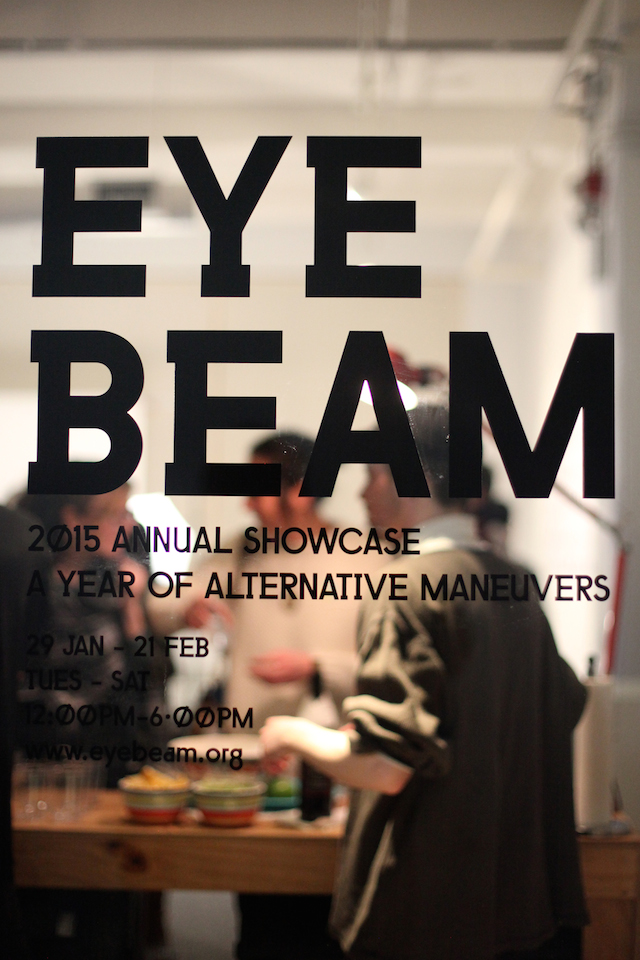 The Eyebeam 2015 Art and Technology Showcase is on display from January 30th through February 21st in Gallery 216 at 111 Front Street, Brooklyn. Click here to learn more.Follow Kate Messinger on Twitter: @methemessingerRelated:Meet The Artist Who Launched The First Kickstarter-Powered Art Exhibition[Photos] 19th Century Romanticism Gets An Update At Eyebeam's Group Show "The New Romantics"Ladies Only: Dispatches From The Last Of The Grand Brucennials
The Eyebeam 2015 Art and Technology Showcase is on display from January 30th through February 21st in Gallery 216 at 111 Front Street, Brooklyn. Click here to learn more.Follow Kate Messinger on Twitter: @methemessingerRelated:Meet The Artist Who Launched The First Kickstarter-Powered Art Exhibition[Photos] 19th Century Romanticism Gets An Update At Eyebeam's Group Show "The New Romantics"Ladies Only: Dispatches From The Last Of The Grand Brucennials
Advertisement
Untitled Attitudes by Nancy Nowacek


Advertisement
Untitled Cellphone Mic Jammer by Allison Burtch

Minicade by Chloe Varelidi and Atul Varma

Advertisement

